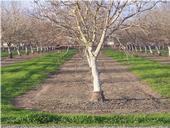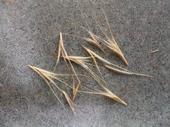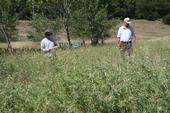- Posted By: Brad Hanson
- Written by: Kurt Hembree, Ryan Allen, Curtis Rainbolt, Jim Mueller et al., Richard Smith and Larry Bettiga, Emilio Laca et al., and others

Today I thought I'd put in a plug for the California Weed Science Society (CWSS) annual meeting to be held January 23-25, 2012 in Santa Barbara. Information on the meeting can be found in the October newsletter at: http://www.cwss.org/PDF/CWSS_Fall_2011_Newsletter.pdf and links to the Program and Registration can be found at: http://www.cwss.org/. The main CWSS page also has information on a new Photo Contest, the Student Paper and Poster Contest, the Student Scholarship Program, and Awards and Honors presented to students and members last year.
Also, I've attached a link to the
- Posted By: Brad Hanson
- Written by: WSSA press release

Weeds can be introduced to new areas from a variety of natural and human-influenced sources. Seed transport on vehicles or equipment can be a very important mechanism of spread.
The WSSA article below focuses on transport of invasive weed seed on recreational and work vehicles in rangeland areas but the same concepts hold true in agricultural or residental situations. Have you ever run a mower or tiller through a weedy area and then looked closely at the amount of vegetative matter (and potenially seeds) on the mower deck or in the nooks and crannies of the machine? All that junk (and seeds) can fall off in subsequently visited areas and introduce new weed species or biotypes into the new area.
It is a good...
- Author: Chris McDonald
How many times do we see some plant that looks unusual, we let it sit for a while, pondering its existence (maybe that's just me), and then realize its some plant we have never seen before? In that moment we try to find it again and its either gone or gone to seed!
One concept that is difficult to grasp is exponential growth. This is not the basic math, growth model that is familiar (if I have earn $5,000 selling seeds, then after ten years I'll have $50,000, yeah!). Its like growth on steroids. This is the growth that produces stunning results that boggle the mind. I think we have all seen the gimmicks, chain letters and recipes, facebook posts giving 5 people good luck, Bernie Madoff they are all based on exponential...
- Posted By: Guy B Kyser
- Written by: Guy Kyser

Joe DiTomaso, John “JR” Roncoroni, and I evaluated a purple starthistle trial in Napa County last month. Several selective herbicides, two times of application, etc etc… one of the replications got flooded out, so I can vouch that Very High Rates of H2O are capable of controlling this weed… but the point of this post is a neat idea that JR had during the evaluation.
With digital cameras, it's become more or less routine to photograph every plot during evaluation. Sometimes it really helps with interpreting the data if you can take another look at the plots after running the statistics. But many of our plots are a long drive away, and in the meantime the sun has turned all the vegetation into...
- Author: Guy B Kyser
Last entry I talked about the problems with artichoke thistle (Cynara cardunculus L.) in the Sacramento Delta and other coastal regions. Again, this thistle was introduced to California as the cultivated artichoke, but escaped to become a serious rangeland weed.
Because stands of artichoke include perennial adults, new seedlings and a persistent seedbank, the best means of control is likely to be broadcast application of a selective herbicide with both foliar and soil-residual activity.
Starting in fall 2010 we tested several such treatments at a dense infestation of artichoke thistle in the Montezuma Hills, Solano County. We made applications at three timings: fall (December 16, 2010), winter (January 26,...


